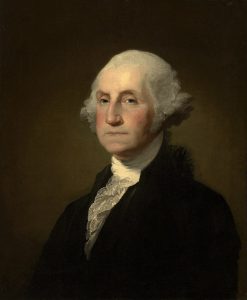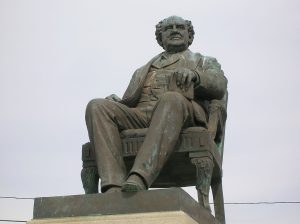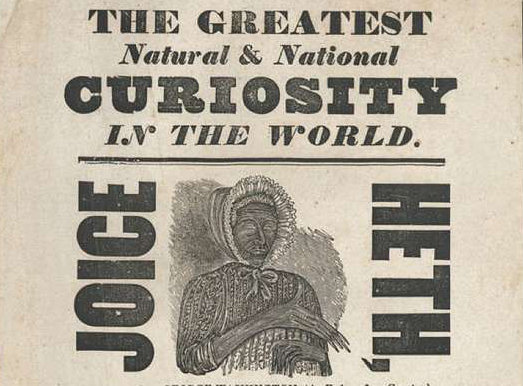He was a true salesman, bombastic in the pitch. To get ahead, he’d traffic in lies, and exaggeration.
He manipulated the media, planting stories in competing publications to build confusion and distrust. A Democrat that became a Republican, he understood the power of the crowd – and the mob.
One of the most iconic American figures of the 19th century, circus king P.T. Barnum is still remembered today as the “Great Showman,” who had the ability to sell great public hoaxes to make money.
“At the outset of my career, I saw that everything depended upon getting people to think, and talk, and become curious and excited over and about the ‘rare spectacle,’” Phineas Taylor Barnum later wrote.
Beyond the bluster, Barnum was a Connecticut-born Lincoln loyalist whose support of the anti-slavery movement in the 1850s saw him leave the Democratic Party. The Greatest Showman, a 2017 biopic that starred Hugh Jackman, painted him as a big-hearted cad.
Yet often buried deep within the Barnum mythology is the shocking story of how he got his start, leasing an elderly Black slave who he’d exhibit as President George Washington’s 161-year-old nursemaid.
Following her death in 1836, the ‘Great Showman’ delivered Joice Heth one last indignity, holding a public autopsy for her in a New York City saloon that 1500 paid tickets to view.
“If one is making a movie glorifying P.T. Barnum,” Dr. Jim Wright, who wrote a well-researched 2017 Clinical Anatomy essay on Barnum’s treatment of Heth, tells me, “it probably wouldn’t help with marketing it if you pointed out you avoided how he actually started his career.”
A fateful meeting
Barnum was a 25-year-old businessman, who’d struggled as a store owner, newspaper editor, and lottery official when he first encountered Heth in Philadelphia, in 1835.
Though unclear, Heth’s origins are thought to be in Kentucky, where she was originally owned by John S. Bowling and exhibited in Louisville, using Washington’s story. In 1835, she was purchased two different times by small-time showmen, who toured her around the wider region.
“If one is making a movie glorifying P.T. Barnum, it probably wouldn’t help with marketing it if you pointed out you avoided how he actually started his career.”
When Barnum was introduced to her by her owner (either Coley Betram or R.W. Lindsay), Heth, according to the account published by JSTOR Daily, was blind, without teeth, and suffering from paralysis in her limbs.
“Despite her appearance,” Barnum later wrote in his memoirs, “she was friendly and talkative. She ‘related many interesting anecdotes of ‘her dear little George.”
A ‘bill of sale’ connecting her with the Washington family was shown, supposedly convincing Barnum of the authenticity of her story, as well as her improbably advanced age.
Heth was offered to Barnum for $1000. With slavery illegal in the North, Barnum instead negotiated to “lease” Heth for a year, paying for his half with a loan, and recruiting a business partner, Levi Lyman, for the rest.
Starting that August, she toured taverns, inns, lodges, and concert halls around New England. Describing her as “the most astonishing and interesting curiosity in the world,” Barnum advertised Heth as being born in Madagascar in 1674, and serving the Washington family in rural Northern Virginia.
At other times, he planted stories in the ‘yellow press,’ claiming her to be an “automation” made of rubber, whalebone, and springs. When abolitionists questioned Barnum, he claimed profits would be used to free Heth’s grandchildren from slavery.
After being manipulated by Barnum for more than six months, Heth died in New York City on February 25, 1836.
The “Greatest Showman” had one last appalling stunt in store for her. He bought in well-known New York surgeon Dr. David L. Rogers, and declared he would hold a public autopsy of Heth to prove—once and for all—her incredible age, and story.

A shocking day on Broadway
Broadway’s City Saloon was rented the following day, with Barnum charging onlookers 50c (around $30 today) to watch. Though public dissections were more common—Rogers performed one on notorious pirate Charles Gibbs, who was hanged in New York in 1831—autopsies, with crowds, were rare.
The lack of respect shown towards deceased Black bodies by their former owners is well-documented, with bodies sometimes sold to medical schools for anatomical dissection. Though Massachusetts had passed the first anatomy law in 1831, access to cadavers could be difficult for anatomists and budding surgeons, enabling the racist practice.
“What the consent process would have been to perform a medical autopsy at that time is not 100 percent clear, but certainly by the 1850s, 1860s and 1870s, it’s absolutely clear you needed consent of the family in order to perform a medical autopsy,” Wright says.
“There would have been no way to get consent of the family [with Heth], so I would presume consent of the owner, of a slave, probably would have been sufficient.”
Physicians and medical students were known to have filled the front rows, while Rogers, Barnum, Lyman, and infamous tabloid reporter Richard Adams Locke were standing at the operating table.
“We can choose to erase things or dance around touchy subjects and present a kind of feel-good story, or we can use it as an opportunity to look at the very complex and troubling histories that our culture has been grappling with for centuries.”
With the excited crowd almost certainly exclusively white, the moment paints a chilling picture at a time when widespread protests against racial injustice have spread across modern-day America.
Wright says that Rogers is likely to have been telling the audience what he was doing, while he was doing it. According to the records, he opened her abdominal cavity first, examined each organ, and indicated they had a perfectly natural and healthy appearance.
He then entered the thoracic cavity by cutting through the rib cage and noted the coronary arteries and cardiac valves were not calcified. He did notice tuberculosis in the left lung, which was determined as the likely cause of Heth’s death.
Next, Rogers examined the aortic arch, and the costal cartilages, both of which tend to calcify with age, but found them to be as expected.
“At that point, he announced that Joice Heth could not have been more than 75 or 80 years of age,” Wright says.
“That then started a feeding frenzy with the penny newspapers. Barnum played into it, telling everyone different stories. Because of the result of that, a lot of newspapers were sold.”
“Buried respectably”

Following a final, shocking tabloid ploy that saw him suggest Heth was still alive, and the autopsy took place on the wrong body, Barnum would very rarely mention her for the rest of his life.
“The story of [Barnum’s] life that we choose to tell is in part the story that we choose to tell about American culture,” author Benjamin Reiss, who wrote The Showman and The Slave, told Smithsonian Magazine in 2017.
“We can choose to erase things or dance around touchy subjects and present a kind of feel-good story, or we can use it as an opportunity to look at the very complex and troubling histories that our culture has been grappling with for centuries.”
Following the autopsy, Heth’s body was not returned to her family. Barnum later stated she was “buried respectably” in Bethel, Connecticut, his hometown.
Built four years before he died, a marble statue of the Great Showman was 22 miles away in Bridgeport, where he died in 1891. At 80, he was around the same likely age as Heth was, more than five decades before.





